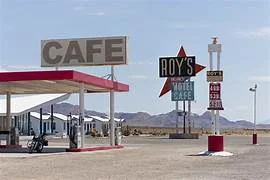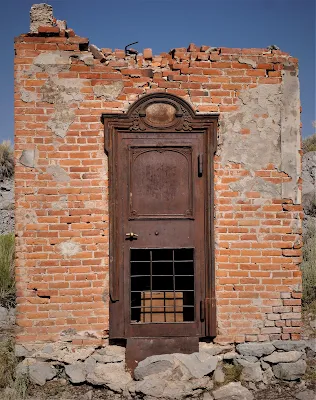 |
| Welcome to Amboy, CA |
“When Albert passed away in 2023,” Ken said, “I wondered what would become of his dream of turning this once vibrant town into a go-to destination for those traveling along Route 66.”
Albert Okura, the founder of the popular restaurant chain Juan Pollo in Southern California, had purchased the nearly forgotten town of Amboy in 2005. Albert loved history, especially the history of Southern California and more importantly Route 66. When he purchased the town of Amboy, his wish was to do all he could to turn it back into the iconic spot where travelers from across the United States would stop along America’s Highway during its heyday.
 |
| The original sign is lit up nightly in Amboy, CA |
Albert knew he could recreate the thrill of travelers along Route 66 that was once felt after the route was completed in 1926. Sadly, Albert passed away on January 27, 2023 at the young age of 72 in Ontario, California.
But, his dream did not die. “His family have been wonderful in keeping Albert’s dreams alive here in Amboy,” Ken said. “Take a walk around and see for yourself all the construction being conducted to complete this place by the summer of 2026.”
That summer would be the 100th anniversary of the completion of Route 66, and there are huge plans being developed along that long river of asphalt stretching from Chicago all the way to Santa Monica.”
Rumor has it that a family of Sasquatches may attend the festivities somewhere along the nearly 2,500 mile highway - but of course, that is on a need-to-know-basis.
And, I need to know!
Before I started walking the property, Ken did inform me that finishing the entire project may be a bit of a stretch but “...knowing Albert’s family as I do, I think we may indeed have everything up and running for the huge crowds that will be coming through. They are an awesome group of folks and I am sure keeping Albert’s legacy alive will be in the forefront of their thoughts.”
I’ve been through Amboy more times than I can count - either heading east or heading west. Did I stop each time? No, but every time I passed by those stark white empty cabins, the large paned windowed reception area of the motel, and the gas station with its huge sign out front welcoming visitors, I felt a slight tug at my heart.
 |
| Road monument with unfished cabins in the rear at Amboy, CA |
The last time I visited and spoke with Ken, a large tour bus had just pulled up and about a million tourists exited. It was a very large custom made bus.
“We sometimes get up to three thousand people visiting a day,” he said. I just saw a million, so I suppose his math could be accurate, rounded off for the year.
As I was taking a snap of some of the construction going on, a tourist walked to me and in a very German accent and said he recognized me.
“Yes, I am John R. Beyer, the world-renowned travel writer,” I humbly responded.
“Nein,” he retorted. “You look like the restroom attendant. Paper is needed in stall three.”
I nodded and then mumbled, “You probably meant number two.”
Ken advised me that 50% of the visitors are European, 35% from the United States, 10% from South and Central America and the remainder from Asia or perhaps the territory of Nauru.
As I wandered here and there, teams of construction personnel were wiring this, harnessing that, and pretty much doing what construction personnel did. They were busy rebuilding Amboy into what Albert Okura had imagined.
 |
| New construction in the works in Amboy, CA |
In fact, in keeping to Albert’s plans, Ken explained that they hoped to have rooms ready to rent, a fully functioning restaurant, and other amenities which made staying in Amboy for more than a couple of hours a reality.
I asked about the family and their thoughts about Albert’s visions.
“I must say that Kyle, one of Albert’s children, comes here quite often and spends long weekends checking out how much work is getting done. Often, Mrs. Okura and other family members accompany him and they love it out here. They are a great and loving family.”
Years ago, my lovely wife Laureen, along with one of our daughters, Kelly, drove through Amboy and were delighted to see the site was being used as a Fly- In. Planes of all makes and models were actually landing along Route 66 and taxing to the small airport located there.
Music, food, and other entertainment were in abundance for all to share in.
Other events which are being coordinated by Ken, the other staff members, and the family are motorcycle rendezvous, classic car shows, airplane fly-ins, music festivals, space alien conventions, and the list goes on and on.
 |
| And gas is available at the original pumps |
Recently a Polish singer by the name of Daria Zawailaow utilized the town for a music video. It is spunky, riveting, and I have no idea what she is singing about - my Polish is rather limited except for some old and now inappropriate jokes.
The below link will show just one of the musical talents who visited Amboy and wanted to share with their audiences what an iconic place this little town is and why it is important to visit.
https://www.youtube.com/watch?app=desktop&v=CoMFkWwevjA
For more information: https://visitamboy.com/
John can be contacted at; beyersbyways@gmail.com
























